- Home
- Giles Foden
2004 - Mimi and Toutou Go Forth Page 7
2004 - Mimi and Toutou Go Forth Read online
Page 7
The landscape near Elizabethville was dotted with anthills, some as high as 40 feet. Elizabethville itself barely existed. Built to serve the Star of the Congo copper mine, it consisted of a line of corrugated-iron shacks along a red-dust road. Most of the buildings were barns for storing mining and railway equipment, or light industrial workshops for mending it. There was a single whitewashed villa where the Vice-Governor-General lived, a few brothels and drinking dens, and a flea-pit hotel. It was here the following morning that Lee and Magee turned up out of the bush, to present themselves to Spicer.
Magee has left an account of the work they had done, and one can imagine Lee telling Spicer much the same thing:
Where slopes were too steep they were levelled down. Bridges, constructed from timber growing on the spot, were thrown across river-beds. Giant trees, when blocking our path, were uprooted with dynamite. Rocks and boulders were treated in a similar manner. Our biggest problem was a dried-up gorge, 40 yards wide and about 20 yards deep. This we completely filled up with tree trunks. Thousands of trees were cleared out of the way. The enormity of this task may be appreciated better by the reader when he learns that so dense was the growth of the bush in some sections of the route that it was possible to travel for several days at a time and get only an occasional glimpse of the sky through the tangled foliage overhead. So the 146-mile roadway was pushed ahead, making, as it progressed, an unavoidable climb over a plateau 6,000 feet above sea level.
§
Spicer waited until Lee had handed over his survey maps and contracts for labour before dropping his bombshell. He informed him that he had been accused of insulting the Belgian flag while drunk and of giving out information about the expedition to all and sundry. Lee vehemently denied the accusations—adding, according to Shankland, that ‘if everyone knew that the expedition was bound for Lake Tanganyika it was for the very simple reason that there was nowhere else it could possibly be going to’.
This was true. It had been the case even down in Cape Town, where Dr Hanschell and ‘Tubby’ Eastwood had been surprised how easily people had worked out what they were up to. But this cut no ice with Spicer. He ordered Lee to return to Cape Town and await disciplinary proceedings from the Admiralty. Without another word, the seasoned big-game hunter collected his wages from Eastwood, the expedition’s paymaster, and disappeared. From this point on, the progenitor of the Naval Africa Expedition drops out of history. If he was related to the Lee family of Mangwe near Bulawayo, he may well have returned there.↓
≡ John Lee of Mangwe was a famous big-game hunter of a previous generation who settled in Northern Rhodesia around 1861. He married a niece of President Kruger and fathered many children. He had at least three other wives while in the Mangwe area.
When Eastwood told the other officers of Lee’s departure, the mood turned against Spicer. Lee’s brutal dismissal cast something of a pall over a dinner at the hotel that night, given by the British residents of Elizabethville in Spicer’s honour. But if he felt the strain, Spicer didn’t show it. Instead, he took great pleasure in telling the other diners of his skill at climbing the rigging of old sailing ships. Then, writes Shankland, ‘he embarked on a long story of how he had bagged a man-eating tiger while snipe-shooting in the Southern Provinces of China’.
There was a broken-down piano in the corner of the hotel restaurant and the moment he had finished his tall tale, Spicer sprang up and announced he would sing. One of the expats volunteered to accompany him on the piano and so the officers of the Naval Africa Expedition were treated to the sound of their commanding officer labouring through ‘Swanee River’.
That’s where my heart is turning ever.
That’s where the old folks stay.
All up and down the whole creation,
Sadly I roam,
Still longing for the old plantation,
And for the old folks at home…
The pianist halted at this point, perhaps embarrassed at the spectacle he was making of himself, but Spicer continued, running through every verse and chorus.
All round the little farm I wandered
When I was young,
Then many happy days I squandered,
Many a song I sung.
When I was playing with my brother
Happy was I.
Oh! take me to my kind old mother,
There let me live and die…
This sorry performance met with desultory applause, whereupon everyone quickly rose from the table. Dinner was over. ‘Tubby’ Eastwood and Dr Hanschell returned to the barn in which they had been billeted, while the rest of the expedition slept on the train. Only Spicer stayed in the hotel.
The following morning, most of the expedition moved on to Fungurume a hundred miles up the line. Their destination was now common knowledge, writes Magee, describing their send-off:
The members of the expedition were feted by the Belgian populace, who, however, were not a bit optimistic about the outcome of our efforts to reach the lake. Among the sporting fraternity of this township the betting against our getting through was 100 to 1. However, ‘It’s dogged as does it’ was our watchword and we left the Belgian town full of hope and bearing the good wishes of the townsfolk, who turned out in force to see us off.
Spicer, Eastwood and Dr Hanschell stayed behind in Elizabethville. On the advice of the local Belgian medical officer, the doctor insisted fly-whisks were bought for every member of the expedition, to ward off the dreaded tsetse. Eastwood bought 28 of them at Elizabethville market, including one for Spicer. It turned out the Commander had already, off his own bat, acquired a fancy number with a lion-skin handle.
Three native assistants were also employed: Rupia, who would help Dr Hanschell; Tom, who would be Spicer’s valet; and Marapandi, an older man who had trained in a mission in Nyasaland,↓ who would help Eastwood in his work as clerk and paymaster.
≡ There were many Nyasas in Elizabethville at this period; they were perceived as an elite by the Congolese.
Marapandi was also a fellow worshipper of the stern Methodist God whose hand, Eastwood believed, was always hovering over their enterprise—ready to lift them to salvation or dash them down to that place where tormented souls forever fuel the flames.
On 5 August—nearly two months after they had set out from England—Spicer, Hanschell and Eastwood rejoined the others at Fungurume, deep in the Belgian Congo. Fungurume was the railhead in Cecil Rhodes’ abortive Cape-to-Cairo project; the end of the line. In fact it was just a few sheds in the jungle, with piles of steel railway track and wooden sleepers lying here and there, under the watchful eye of a French-African railwayman known only as ‘Monsieur’.
Here the expedition detrained the boats and started its gruelling journey through the heart of the Dark Continent, reads a caption in Magee’s National Geographic article. To the right and the left of them was rough bush; in front of them, massive and forbidding, lay the Mitumba Mountains, which they would have to cross. The day they arrived, the stores lay along the track in a hopeless mess. Ammunition and petrol tins became dangerously hot under the sun and there was hard work ahead. Still in their wooden cradles, Mimi and Toutou had to be lifted off the train into Spicer’s special trailers. There had already been some damage: parts of the boats’ undercarriage had broken during the rail journey, in spite of the protection afforded by the rubber tyres between their hulls and the wooden cradles.
While the boats were being unloaded (with the help of a small crane lent by ‘Monsieur’), Spicer and Dr Hanschell went ahead in a lorry to check the work Lee had done on the road. There were two native labour camps on the route. One of these was run along strict lines by a Mr Locke—an old Africa hand, ex-Boer War, in dark shirt and riding breeches. The other was the fiefdom of a Mr Davison. He was the more flamboyant character, the doctor recollected: ‘He wore white ducks [strong linen trousers] and an enormous cowboy hat.’ The two camps were more or less villages, complete with women and children. The Africans under Lock
e and Davison had worked hard levelling the ground. They had also gathered firewood for the steam-tractors that were due to arrive from Northern Rhodesia, their job being to drag Mimi and Toutou over the mountains.
In his lecture, Spicer typically ascribes the gathering of African labour as due to his personal charisma: ‘The white man, for certain reasons, is not greatly esteemed on the Belgian Congo; however, the natives learnt that we were a different sort of white man, and within two days I had 1,400 natives available.’
In the afternoon, once the expedition’s own camp had been established and latrines been dug, Spicer decided that a parade was in order. A Union Jack was hoisted up a tree in front of Spicer’s tent and, with their cutlasses pointed outwards at 45 degrees, the officers inspected the men, each of whom held his rifle up in front of him. All wore solar topis. According to Shankland, Spicer made a speech at this point, reading aloud the King’s Regulations and reminding the expedition that they were there for one purpose only: ‘to get Mimi and Toutou through to Lake Tanganyika and then, when they had sunk the Hedwig von Wissmann, to get home again as soon as possible.’
‘And we have another enemy more deadly than the Germans,’ he continued. ‘I mean tropical diseases. Very special precautions are necessary, which will be explained to you in detail by Surgeon Hanschell. Every man in this expedition, in matters of health and hygiene, will unquestioningly follow his instructions. All drinking water will be boiled. Fly-whisks will be issued today, and it will be the duty of every man to whisk flies off his neighbour, irrespective of rank.’
Dr Hanschell himself was the first to fall sick. His old bugbear—that amoebic dysentry he’d caught on the Gold Coast, which had never quite gone away—had returned with a vengeance. He spent the next few days hobbling between his small tent and the latrines.
Spicer was the only other person to have a tent (a much bigger one than the doctor’s). The rest slept in the open air in an area at the beginning of Lee’s road, nestling in their sleeping bags next to the dumps of petrol and ammunition, which were now covered with tarpaulins. Rupia, Tom and Marapandi camped a quarter of a mile away, along with the other African auxiliaries and their wives and children. Further beyond camped Locke and Davison’s labour gangs, their firelights gleaming in the darkness. Locke’s gangmaster came from a family of witch doctors, which is why his men were so well organised. Years later, Dr Hanschell would remember that first night in the true bush: how drum-beats and melancholy chants from the direction of the road-builders’ camp had filled his ears as he fell into an uneasy sleep.
SIX
On 6 August 1915, 67 days from London, Mimi and Toutou were ready to make their overland journey. Forty feet long, eight feet wide and almost 15 feet high (taking into account the trailers), they looked impressive as they lay at Fungurume, the valley gateway to the Mitumba escarpment. Today, when the trappings of modern, so-called civilisation extend into almost every nook and cranny of Africa, for better or worse (or, indeed, both at the same time), it is hard to imagine the visual impact that the two vessels must have had as they rested between the trees. As Magee points out, almost any Western item was regarded with a kind of reverential awe and was much sought after by the local chieftains.
The prevailing mode among these petty potentates seemed to be obsolete uniforms of all armies. One old chief, I remember, was attired in an old British militia tunic and a pair of spats, his crowning glories being an opera hat and a pink sunshade. I was aware that a big business in out-of-date uniforms is carried on between traders and these tribes, but the origin of the spats and pink sunshade puzzled me somewhat…
Fungurume was where the real business began and time was against them. They had to get over the Mitumba range before the rains came and obliterated the roads and bridges being built. This was no idle worry. Of the paralysing effect of the rains, an army officer wrote of the Moshi–Arusha road that ‘its state was indescribable, the wet black cotton soil poached to morass. It was hard work for an unladen man to go two miles an hour.’ Wainwright, the transport manager, had witnessed in the Transvaal how the African rainy season could act like a tidal wave, sweeping all before it, and this made him especially conscious of the need for urgency. With almost 150 homemade bridges to cross or build and 146 miles of rough terrain to cover (including a climb of 6,000 feet over the Mitumbas), they had about eight weeks before the weather would break. Even sentinel showers could prove a problem, for as Magee observed, ‘one good rainfall would render useless our stacks of wood fuel all along the route’.
The first bridge was in sight, thanks to Lee’s good offices. It consisted of logs laid across a stream, over which the red soil of the region had been shovelled and flattened—red because the soil round Fungurume is said to contain the greatest density of copper on earth. Spicer’s men were ready and an armed guard of African askaris, supplied by the Belgians, was on hand: huge men, who marched in bare feet and displayed magnificent discipline. They wore bandoliers and fezzes and carried old-fashioned single-shot rifles. Native carriers had gone on in front, each bearing on his head a load of about 60 pounds. ‘Provisions, ammunition and petrol for the motor boats were all transported in this fashion,’ says Magee, ‘our string of native carriers extending in single file for miles.’ The lorry, carrying further provisions and general camp gear, had been sent on to select suitable camping spots.
During these preparations a thin, blond-haired man wearing khaki shorts and an Australian-style slouch hat cycled into camp. His name was Arthur Darville Dudley and he was a friend of John Lee. He was exhausted, having ridden 200 miles down bush tracks to join them. Lieutenant Dudley had seen service in the Anglo-Boer War and spoke several Bantu languages. He belonged to the Rhodesian Rifles, a force of volunteers composed mainly of farmers and settlers. Disrespectful of hierarchy and liable to wear whatever uniform they could lay their hands on, they were nevertheless generally regarded as tough and useful fighters.↓
≡ Not everyone was of this opinion. One of the volunteers in the Rifles was Arthur Harris (later ‘Bomber’ Harris of Second World War fame) who proclaimed that the colonial troops he rode with were, on average, with remarkably few exceptions, ‘damned bad horsemen and damned bad shots’. It is possible Dudley may have felt the same. A nervous, impatient man, he was also energetic and conscientious. On discovering that before his career in the Boer War, Dudley had been a regular naval cadet, Spicer made him his executive officer.
Meanwhile, Mimi and Toutou—or ‘Mimmie’ and ‘Tow-Tow’ as the ordinary seamen called them—stayed put. The steam traction engines and ox-teams that would pull them had not yet arrived. Spicer grew frustrated and, calling back the lorry, had it fixed to Toutou’s trailer. PO Mechanic Mullin climbed in to the cab and stepped on the accelerator, but the lorry’s wheels simply spun round in the soft earth road. Spicer refused to give up. He ordered some of the native labourers to be brought back and together with the regular members of the expedition they attached tow ropes to Toutou and were able to drag her about 150 yards towards the bridge. The same procedure was applied to Mimi the following day, then Toutou was pulled the remaining 200 yards to the first bridge.
As they were about to cross, Spicer decided to check the special trailers Thorneycroft’s yard had made for him. They had large rubber wheels in the centre and two smaller wheels on manoeuvrable castors at the front and back, mounted on transverse wooden beams, six inches thick. However, on inspection it was found that both these beams had started to split.
‘I told the experts that the six-inch beam was not strong enough!’ shouted Spicer at the surrounding trees. ‘It should have been a twelve-inch beam!’
Mimi showed similar damage. Spicer sent Wainwright and Eastwood back to ‘Monsieur’ at the railhead to see if the broken trailers could be repaired. They purchased two wooden ox-wagons from the railwayman and replaced the broken wheels using pieces from the wagons. This all took another week, by which time the traction engines had arrived by train: they were enormous s
team tractors with extra-large steel wheels at the back and a tall funnel at the front.
The huge wheels were intended to give clearance from the uneven ground and the engines had steel boilers in which water was heated by a timber-fuelled furnace. Each locomotive came with a ten-ton trailer usually used to store wood for the boiler. They had laid stacks of wood along the entire length of the route, however, so the trailers were instead loaded with bags of meal to feed the African labourers.
The ox-teams that were supposed to supplement the pulling power of the road-locomotives had not yet arrived, but Spicer was impatient to get going. On 18 August they set off once more. The steam whistles of the locomotives blew and the African carriers chanted and beat their drums as Mimi was towed on to the bridge.
Within seconds of the first tractor coming on to it, however, the earthwork and timber of the bridge collapsed into the stream below. There was pandemonium as the second locomotive was disconnected from Toutou and put to work hauling Mimi and the other steam engine out of the broken ford.
It was Wainwright who came up with a solution: they had to lay the logs in the stream in the same direction as the current and pile them up until they were level with the road on either side of the gorge, making something more like a causeway than a bridge. The African labourers were set to work cutting down suitable timber and after a few days Mimi and Toutou were ready for a second attempt.
They began at six in the morning. At first all went well. Mimi crossed without difficulty, but then she stuck on the opposite side, unable to build up enough steam to climb a bank beyond the gorge. So another causeway was built that sloped up on to the bank. Toutou crossed on this with the second traction engine, which then helped pull Mimi and the other tractor up over the obstruction. Spicer tried walking alongside the engine as it crossed, but soon jumped off: ‘it was like trying to walk on a spring mattress.’

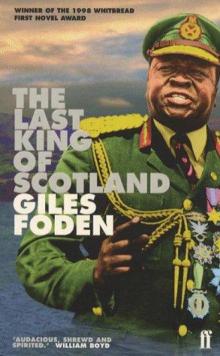 The Last King of Scotland (1998)
The Last King of Scotland (1998) Zanzibar
Zanzibar Turbulence
Turbulence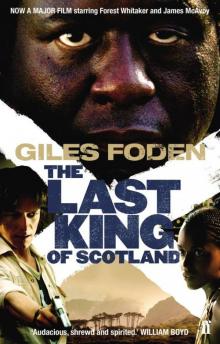 The Last King of Scotland
The Last King of Scotland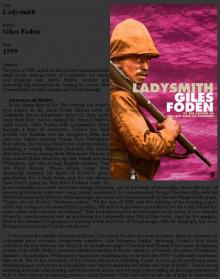 1999 - Ladysmith
1999 - Ladysmith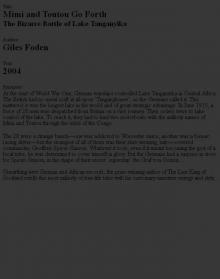 2004 - Mimi and Toutou Go Forth
2004 - Mimi and Toutou Go Forth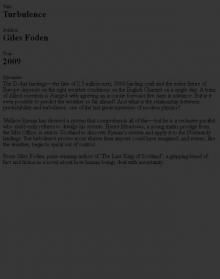 2009 - Turbulence
2009 - Turbulence